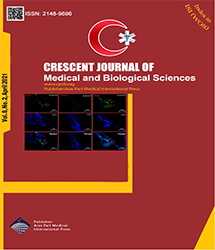
| Original Article | |
| Toxigenic Clostridium difficile Infection in Children: Performance of Toxin A/B Immunoassay | |
| Jalal Mardaneh1, Alireza Mohammadzadeh1, Saeede Bagheri2, Maryam Baniasadi3, Masoud Yousefi4, Gholamreza Pouladfar5, Mojtaba Anvarinejad5 | |
| 1Department of Microbiology, School of Medicine, Infectious Diseases Research Center, Gonabad University of Medical Sciences, Gonabad, Iran 2Student Research Committee, Gonabad University of Medical Sciences, Gonabad, Iran 3Laboratory of Microbiology, Allame Bohlool Hospital, Gonabad University of Medical Sciences, Gonabad, Iran 4Department of Microbiology, School of Medicine, Birjand University of Medical Sciences, Birjand, Iran 5Professor Alborzi Clinical Microbiology Research Center, Nemazee Hospital, Shiraz University of Medical Sciences, Shiraz, Iran |
|
|
CJMB 2021; 8: 122-126 Viewed : 5012 times Downloaded : 3150 times. Keywords : Hospitalized patients, Children, Diarrhea, Toxigenic Clostridium difficile |
|
| Full Text(PDF) | Related Articles | |
| Abstract | |
Objectives: Clostridium difficile is a major nosocomial pathogen that infects the large intestine (colon) and causes a range of clinical manifestations from mild to severe diarrhea. The aim of this study was to assess the detection of pathogenic toxin A/B-positive C. difficile strains among hospitalized patients with diarrhoea in Gonabad, Iran. Materials and Methods: In this cross-sectional study, hospitalized patients submitted to 22 Bahman Hospital (Gonabad, Iran) were included if they had a liquid stool specimen. From November 2016 through July 2017, a total of 50 sequential stool samples (unformed or liquid) were obtained from hospitalized patients for inclusion in this study. The stool samples were collected and C. difficile toxin A/B immunoassay was performed according to the manufacturer"s guidelines. Results: Based on the results, the maximum number of cases belonged to the age group of less than 10 years (n=29, 58%). Most studied patients were hospitalized in the pediatrics ward (n=24, 48%). Among the studied patients, 16 (32%) cases were positive for C. difficile toxin A/B by immunochromatographic assay. Frothy-four (88%) patients received one or more antibiotic treatment on admission and hospitalization. Ceftriaxone was the most common applied drug for the treatment of these patients. Finally, 5 (31.25%) patients received combination therapy. Overall, 34.48% of pediatric cases were positive for C. difficile toxin A/B. Conclusions: Our results showed that the emergence of potentially highly virulent and antibiotic-resistant C. difficile isolates is alarming. The diagnostic of pathogenic C. difficile by the clinical microbiology laboratory can improve the handling of disease and more reasonable use of antimicrobials by the physician. |
Cite By, Google Scholar
Google Scholar
PubMed
Online Submission System
 CJMB ENDNOTE ® Style
CJMB ENDNOTE ® Style
 Tutorials
Tutorials
 Publication Charge
Medical and Biological Research Center
About Journal
Publication Charge
Medical and Biological Research Center
About Journal
Aras Part Medical International Press Editor-in-Chief
Arash Khaki
Deputy Editor
Zafer Akan


















